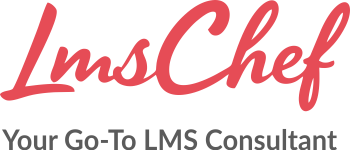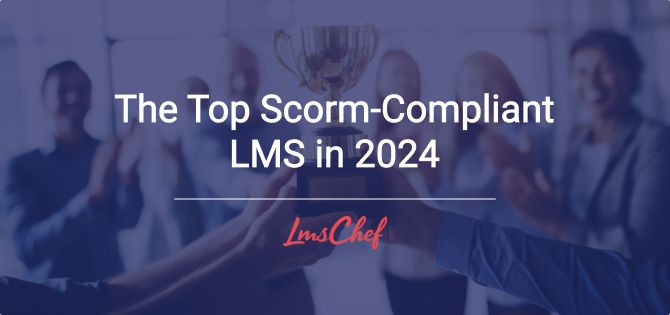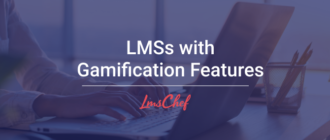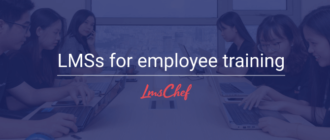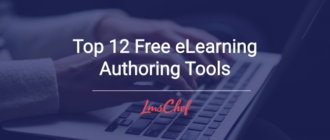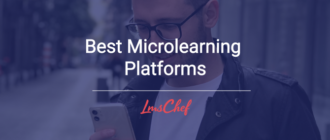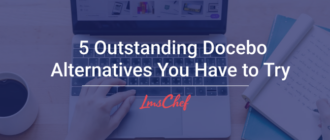A study by Brandon Hall Group revealed that 44% of companies aren’t happy with their current learning management software and want to replace it within the next two years.
The reason behind this dissatisfaction is that organizations want a platform that’s more user-friendly, flexible, and better able to integrate with other systems.
LMS migration can be a challenge, especially if you have legacy content that may not be compatible with your new system.
If that’s a concern for you, opting for a SCORM-compliant LMS is a good solution.
That way, you can ensure your training content works well across multiple platforms that use this widely-known industry standard. You can also migrate to a new solution without losing your existing learning content.
Don’t worry if you struggle to get your head around technical terms like SCORM compliance, I’m here to break it all down into clear and simple terms.
Keep reading to learn:
- Why you need a SCORM compliant LMS
- SCORM 2004 vs. 1.2
- How to choose the right platform
- The top 5 SCORM LMS software in 2024
What Is a SCORM Compliant LMS and Why You Need One
A SCORM-compliant learning management system follows the industry standards I mentioned above.
This means the LMS software supports this format of eLearning content, allowing you to open, edit, and share it on the platform.
It also means the system is set up to communicate with the eLearning content, sharing learning data like who completed a module and their final assessment score.
As a result of this communication, you can gather comprehensive data about training activities and extract it as an LMS report.
If you create eLearning content as a SCORM file, any compliant learning management system can host the course and track learner data.
Now, let’s get a bit more technical.
The three levels of compliance are:
- Compliant
- Conformant
- Certified
These levels refer to how many CMI elements the system supports. I’ll not dive too deeply into what CMI elements are, but they’re essentially the number of commands the LMS can follow and the different data types it can gather.
SCORM compliant LMSs are the most basic of the three levels, but they meet the needs of most organizations. They support basic interactions between your eLearning content and the platform, measuring key data like learning progress and completion.
Conformant LMSs support a broader range of CMI elements, giving you access to more detailed learner data. For instance, you can see details on how learners answer assessment questions (for SCORM 1.2 and 2004 courses).
For both compliant and conformant solutions, this means that while the vendor has likely run tests, they haven’t been certified by a third party.
Finally, SCORM-certified learning management software offers the highest level of support and data. These systems have been verified by a third-party organization known as Advanced Distributed Learning (ADL).
In the vast majority of use cases, the first level of compliance more than covers companies’ training needs.
SCORM 1.2 vs. SCORM 2004: What’s the Difference?
The very first version of SCORM came out back in 2000. Just a year later, an updated version was released – SCORM 1.2.
The 1.2 edition is still the most commonly used version because almost all eLearning tools support it.
That said, the newer edition, SCORM 2004, is gaining popularity thanks to its improved navigation features, including support for adaptive learning pathways.
The 2004 version boasts enhanced data models, accessibility, error handling, and xAPI integration. As such, it’s a smart option to future-proof your training content.
However, organizations with high volumes of legacy eLearning materials should stick with 1.2.
How to Choose a SCORM Compliant LMS: 7 Key Questions
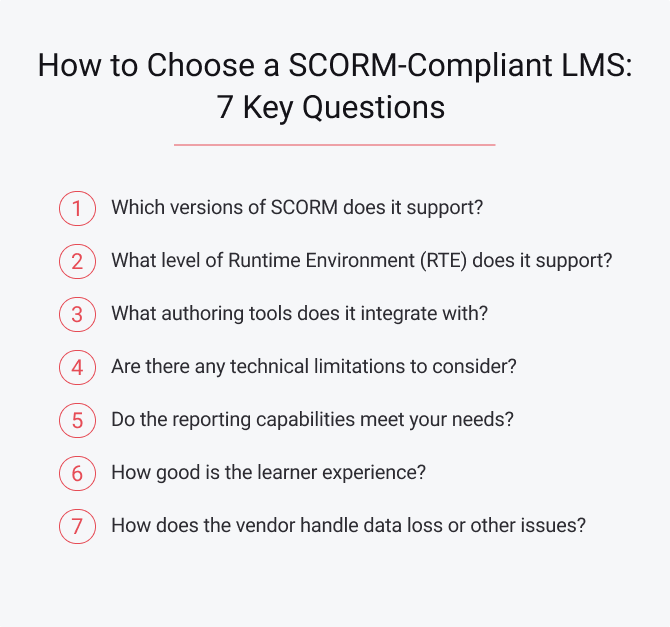
There are over 800 LMSs on the market, and this figure is only getting larger. This can muddy the waters when it comes to choosing the right solution for your organization.
Follow this checklist to choose the best SCORM compliant LMS to suit your training needs and business goals.
1. Which versions of SCORM does it support?
Your first step should be to assess whether the LMS is compatible with your legacy content. For instance, if most of your courses are SCORM 1.2 or SCORM 2004 files, you’ll need a platform that supports these.
2. What level of Runtime Environment (RTE) does it support?
A runtime environment (RTE) refers to the environment your computer program operates in. It also controls how the program communicates data with the computer hosting the program.
If this sounds technical, that’s because it is.
Luckily, as an L&D or HR pro, you don’t need to worry too much about this.
All you really need to know is that if an LMS doesn’t have RTE communication, it can only launch the Sharable Content Objects (SCOs).
SCOs are the individual building blocks that make up any online course or module. If your LMS can only launch these, it means it can’t collect meaningful learning data.
In short, you’ll need a learning management system that supports RTE communication if you want to gather valuable insights into your training courses.
There are two RTE communication tiers.
| First-tier | Second-tier |
| – cmi.completion_status & cmi.success_status – cmi.score.scaled – cmi.session_time – cmi.location – cmi.exit | – interactions (the LMS reports the results of each assessment response) – objectives (the platform offers granular reporting about how well learners meet objectives) – cmi.progress_measure (the system ca display a percentage progress bar) |
| These elements are the fundamentals and are typically considered the industry norm. | If your organization needs granular reporting capabilities, the second tier is your best option. |
3. What authoring tools does it integrate with?
The big advantage of SCORM is that you get optimal interoperability between your authoring tool and the LMS.
That way, you can build online courses as packages in your authoring toolkit and easily upload them to your learning platform.
4. Are there any technical limitations to consider?
When choosing your software, you need to think ahead. Will it scale with your training operations? Are there any limitations that could pose problems down the line?
A careful audit and a detailed list of your requirements can help ensure your software checks all your boxes.
As an example, it’s best to choose a SCORM LMS that doesn’t require additional plugins and uses HTML5 and JavaScript for better device compatibility. This ensures you have access to modern functionality and is essential for implementing mobile learning.
5. Do the reporting capabilities meet your needs?
Understanding what learning data you will need can make it easier to choose the right SCORM-compatible LMS.
6. How good is the learner experience?
At the end of the day, SCORM compliance is supposed to create a better experience for both learners and admins. So, look out for certain features when choosing your software.
I recommend choosing a platform that:
- has a tool for updating content while preserving previous data (imperative for compliance training)
- offers a content version control system
- doesn’t open online courses in a new window (this can frustrate learners)
- shows learners a progress bar as they move through training
- supports mobile learning
7. How does the vendor handle data loss or other issues?
In the event that there’s a bug or other unexpected problem, you’ll want to know that the vendor has a plan in place.
As such, it’s always a good idea to ask the service provider what debugging mechanism they use and how they deal with this type of emergency.
List of top LMSs
Now you know what you’re looking for, here’s a list of the best SCORM LMSs in 2024.
1. iSpring Learn
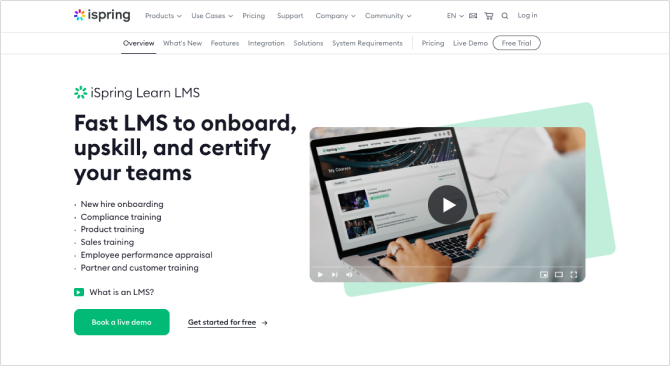
iSpring Learn is a leading SCORM compliant LMS with powerful features and a 30-day free trial.
iSpring Learn is an intuitive, cloud-based LMS that supports SCORM 1.2 and 2004. It comes with a stellar list of valuable features that make it ideal for every type of training scenario.
With iSpring Learn, you can automate training management tasks, create personalized learning tracks, streamline your employee onboarding, and localize training content. You can also leverage the gamification tools to motivate learners.
It integrates with essential corporate tools like Zoom, Microsoft Teams, Salesforce, Shopify, and Bamboo HR
One of the standout features is its integrated top-class authoring tool, iSpring Suite. You can make quality eLearning courses in minutes with this award-winning authoring tool. That includes roleplays for customer service training, interactive quizzes, and virtual classes to support your blended learning program.
Another highlight is the comprehensive 360 staff appraisal tool that’s perfect for tracking staff competencies and plugging knowledge gaps.
Key features:
✓ Supports SCORM 1.2 and 2004
✓ Unlimited cloud storage – ideal for enterprises with a large training catalog
✓ Built-in 360 employee performance appraisal tool so you can visualize your team’s competencies
✓ Integrates with an award-winning authoring tool, iSpring Suite, so you can design your own SCORM files and run them seamlessly on the platform
✓ Newsfeed to keep staff engaged and updated on the latest training or product news
✓ User-friendly mobile app with offline learning support
✓ Strong analytics and reporting to measure training success
Price:
From $2.29 USD per user/month (billed annually).
Our Verdict:
Thanks to iSpring’s intuitive interface, flexibility, and top-tier customer support, I rate this as a top choice for SMEs looking for an LMS they can get up and running right away.
2. LearnUpon
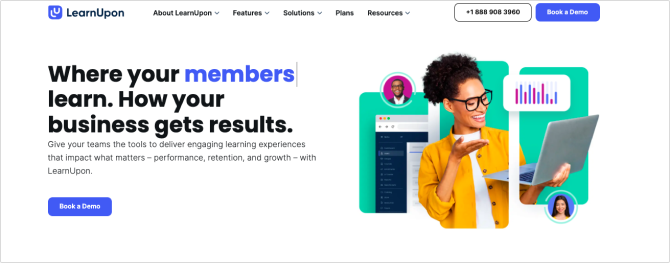
LearnUpon is a popular SCORM LMS that supports diverse use cases.
LearnUpon is another cloud-based LMS that offers a wide range of functionality from one platform.
This popular platform boasts all of the common LMS features you would expect, including social learning, gamification, and integrations with leading tools.
But its most notable feature is the “learning portals” which allow you to create different learning environments for different learner segments. This creates a truly personalized experience.
LearnUpon is suitable for a wide range of use cases, including training employees, partners, and customers.
Key features:
✓ Supports SCORM 1.2 and SCORM 2004 (third and fourth editions)
✓ Learning portals to create segmented learning environments for different employees
✓ Online storefronts to sell your training courses at scale
✓ AI-powered learning solution
✓ In-built course creation tool
✓ Out-of-the-box reporting to track learner progress and behaviors quickly
Price:
From $599 USD/month (billed annually). Free trial available.
Our Verdict:
I think LearnUpon’s quick setup, rich list of features, and price tag best suit larger enterprises looking to scale internal employee training.
3. SAP Litmos
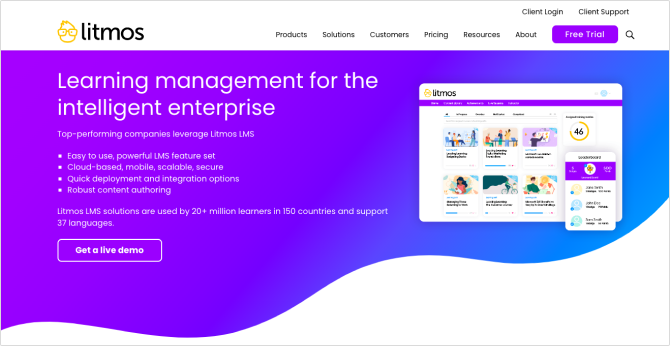
Litmos LMS solution is a SCORM-compliant platform ideal for enterprises.
SAP Litmos is a SCORM LMS that’s ideal for enterprises. As well as all the fundamental features of a learning platform, it also offers a risk list of integrations, a library of off-the-shelf courses, and mobile learning.
One of the highlights of this solution is the AI-powered video assessment tool. This allows learners to record and upload videos of themselves. Then, an AI tool assesses the keywords and rate of speech. This is a valuable tool for training that involves giving presentations or product pitches.
Another standout feature is the high level of customization. You can fully customize your training materials to align with your brand and choose out-of-the-box connectors (or build your own) to integrate the LMS with your tech stack.
Key features:
✓ Compatible with SCORM 1.2 and 2004 (third and fourth editions)
✓ Built-in content authoring capabilities to build your own courses
✓ Course library of ready-to-use training courses
✓ Highly customizable platform to align your learning environment with your branding
✓ Out-of-the-box e-commerce capabilities
✓ AI-powered video assessment to boost employees’ public speaking skills
Price:
From $6 USD per user/month. A free 14-day trial is available.
Our Verdict:
SAP Litmos has some really great integration and customization options, as well as a scalable pricing plan. As such, I think it’s a top choice for large enterprises looking to create and deploy eLearning content in-house.
4. Docebo
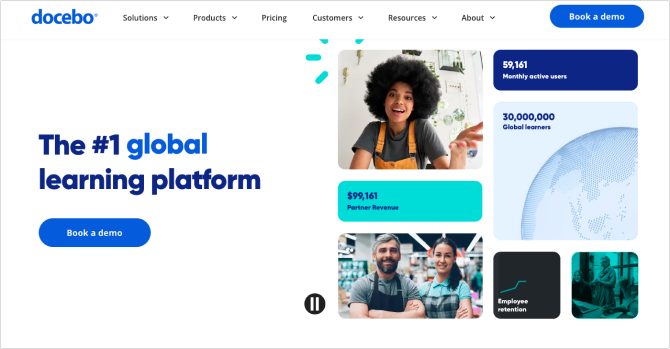
Docebo is a SCORM LMS that’s suitable for a wide range of training scenarios.
Docebo is an AI-backed LMS that is compatible with SCORM 1.2 and 2004. As well as the essentials, such as reporting, a mobile app, gamification, and automation, it also offers some notable extras.
For starters, it integrates with 400+ leading tools, allowing you to incorporate the platform into your existing tech stack seamlessly.
The AI tagging also allows you to map out employee competencies and make content suggestions based on their needs. This is a great addition to your upskilling or reskilling training strategy.
Key features:
✓ Compatible with SCORM 1.2 and 2004 (third edition)
✓ AI-powered virtual tutor and auto tagging
✓ Social learning features
✓ 400+ integrations with leading corporate tools
✓ Mobile App Publisher to create your own branded app
✓ Native LMS integration with Salesforce CRM
Price:
Pricing upon request. Free trial available.
Our Verdict:
Docebo has some interesting AI-backed features that make it a great candidate for mid-to-large-sized businesses looking to train both internal employees and partners.
5. Totara Learn

Totara is a flexible employee development platform that’s compatible with SCORM.
Totara Learn is a talent development solution with an interesting set of integrated tools. Its Enterprise LMS comes with a range of features that can enhance training in your organization.
This multi-purpose platform offers personalized learning plans, strong content management features, and tools to oversee compliance training. What’s more, it’s designed to upskill and manage employee performance from one centralized location.
Some of the standouts include full graphical reporting features, hierarchies to represent your business structure, and a staff evaluation tool.
The “Audiences” system also makes it easy to create training programs for different members of your organization based on their seniority or role.
Since it’s an open-source platform, your organization can fully customize it to meet your needs, with no software license fees.
Key features:
✓ Supports SCORM 1.2 and 2004
✓ Bulk assign tool to recreate your employee hierarchy easily
✓ Performance management tools to engage employees and measure progress
✓ Face-to-face booking system to manage in-person training sessions
✓ Dynamic audiences based on job role or organizational section
✓ Graphical reporting features
Price:
Pricing upon request. Free trial available.
Our Verdict:
Totara offers a lot of flexibility and different employee development tools all from one open source platform. With that in mind, I think it’s ideal for SMEs with a strong focus on performance management and internal tech support to manage the system.
Next Steps
Choosing a new training platform for your organization is a big responsibility. With budget, organizational needs, experience level, and implementation to consider, it’s not a decision to make lightly.
And if you decide to switch to a different solution down the line, you need to make sure that your eLearning materials will still work seamlessly.
Before you start narrowing down your platform choices, I recommend you opt for a SCORM-compliant LMS. This is the best way to ensure your legacy content still works after the migration and keeps you in line with the industry standard.
I hope this guide helps you during the decision-making process.
